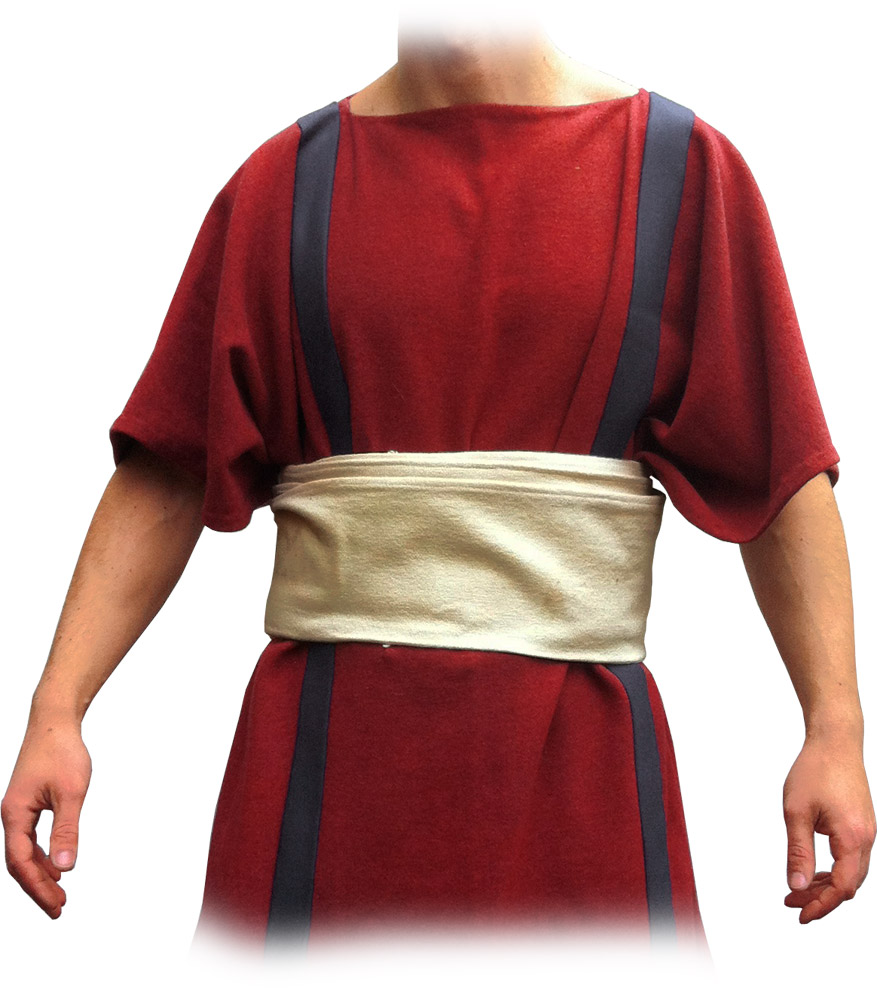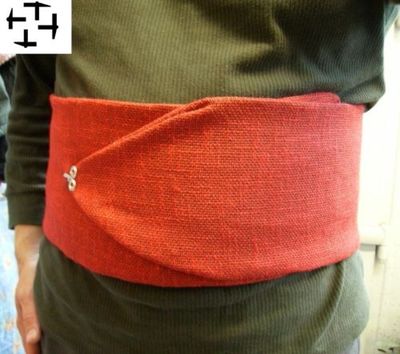Fascia Ventralis
The Fascia Ventralis: A Folow Up
By Peter de Haas, ARMA
 On leafing through the Proceedings of the 5th ROMEO (BAR S476) my attention
was caught by H.-J. Ubl's contribution on the Fascia Ventralis. As handyman of the Gemina Project I welcomed
the discovery of a new piece of equipment, but I could hardly have foreseen the consequences this discovery
would have for my performance in Gemina
issue armour.
On leafing through the Proceedings of the 5th ROMEO (BAR S476) my attention
was caught by H.-J. Ubl's contribution on the Fascia Ventralis. As handyman of the Gemina Project I welcomed
the discovery of a new piece of equipment, but I could hardly have foreseen the consequences this discovery
would have for my performance in Gemina
issue armour.
For those not acquainted with the article: on the evidence of tombstones and in particular a statue discovered in Casacco (Italy), Dr Ubl deduces that the Roman soldier wore a body belt (Leibbinde, fascia ventralis) wound tightly round the waist between the tunic and the belts. He compares this waist band with the sash/shawl of eastern male dress. Dr Ubl draws the following conclusions from his observation:
- the fascia ventralis seems to have determined the drapery of the tunic's folds;
- it would ease the pressure of the crossed belts on the sensitive area of the stomach and hips;
- the thickness of the cloth would protect the skin from bruising and grazes caused by the heavy metal belts;
- the roll of cloth would support the belts, thus keeping the side arms in the correct position;
- the folds of the fascia ventralis would form a convenient pocket for personal possessions. By way of experiment, I folded a remnant of flannel 350 x 60cm double lengthwise, stitching it to give a strip 30cm wide. A shorter length might have been sufficient but I found three turns around the waist the most satisfactory. I have now worn the sash during several of our displays and would like to report on my experiences, beginning with comments on the points raised by Dr Ubl.
1. Folds
I used to tie a string around my waist, pulling the extra length of the tunic up and pouching it over so
that the hem just touched the top of my knee, but the decorative pleats, which appear more or less
automatically, sag out quite quickly when walking in kit. In addition, while marching, the tunic tends to
work up under the armour, ending up like a mini-skirt. Actually this effect can also be observed on
tombstones. But the fascia ventralis changes all this. The tunic is pulled up a bit further over the cord
and the sash is wound tightly round the waist, being secured by a pin (fibula). Then the front of the tunic
is pulled down just below the knees and the curved folds familiar from the tombstones appear of their own
accord. On the march, the tunic again works up a bit, ending up just above the knee, but exposing no
indecent length of leg and retaining the fold pattern more successfully. Obviously, thin cloth keeps the
pleats for longer than thick cloth, though they don't last forever in either case.
Did soldiers worry
about the pleats in their tunics? I have no idea. One thing is certain, the sculptors permitted themselves
considerable artistic license in depicting them.
2. Protection from the pressure of the heavy belts
 The tight fitting sash indeed helps to alleviate the pressure of the heavy
crossing sword and dagger belts. If a mail shirt is worn over the fascia ventralis, the belts rest on the
bulge of the cloth instead of on the hips, which at the same time reduces the threat of them slipping down.
The crossed belts also seem to stay in position rather better when the fascia ventralis is worn.
The tight fitting sash indeed helps to alleviate the pressure of the heavy
crossing sword and dagger belts. If a mail shirt is worn over the fascia ventralis, the belts rest on the
bulge of the cloth instead of on the hips, which at the same time reduces the threat of them slipping down.
The crossed belts also seem to stay in position rather better when the fascia ventralis is worn.
3. Bruise protection
That a thick layer of cloth will prevent bruising by the weight of the belts and grazing by the sharp protrusions of the metal fittings is logical enough (see below, point A).
4. Keeping belts and weapons in place
When the belts are buckled crosswise over the fascia ventralis it is virtually impossible. for them to shift
to either side. This automatically means that the weapons suspended for the belt will remain securely in
place.
Here, however, we arrive at a difficult point, since, if the soldier is wearing his tunic,
fascia ventralis and belt, this implies that he is not in combat dress but in fatigues. Why then should he
have his weapons at the ready?
Though the weapons do not slip down when the belts are worn over a mail
shirt with the fascia ventralis underneath, they can move round, as the mail presents a fairly smooth
surface. Would the fascia ventralis have been worn over mail? If so, why is it never depicted in this
fashion?
5. The fascia ventralis as handbag
On several reliefs the soldiers have 'something' stuck behind the belt. This is often interpreted as a wax
tablet. Dr Ubl, however, points out that a wooden tablet carried thus would be quite painful, and the wax
might even melt due to body heat. From personal experience I can report that carrying a tablet in the fascia
ventralis poses no problems (except when bending down), neither does the wax melt. All the same, I find Dr
Ubl's alternative far more attractive. He suggests that the flat, rectangular object is a leather or cloth
purse for personal items. Furthermore, if the last turn of the fascia ventralis is doubled, an open pouch
about 15cm deep is formed in which coins, a comb or knife can be secreted. Other solutions to the problem of
pocket-less clothing, which come to mind, are the Scots sporran and the Hussar's sabretache. Why should the
Roman soldier not have sought some way of carrying his knicknacks comfortably without having to lug a
handbag around?
So much for the points made by Hans Jorg Ubl. These are quite sufficient to
justify the existence of the fascia ventralis. But I might add a few extra observations, which will perhaps
make the addition of the fascia ventralis to our equipment even more acceptable.
- The cingulum has rather a lot of rivet ends and other sharp protrusions at the back, which can rip the tunic — an item which the soldier would have to replace himself. Damage can be limited by wearing a protective layer of cloth under the belts and protection of the stomach would have been a very welcome side effect. A fascia ventralis can be made easily, using a scrap length of cloth, and would be much easier and cheaper to replace than the tunic itself.
- The tightly wound fascia ventralis supports the small of the back, which makes it easier to endure the weight of the belts, weapons and armour for longer periods. Though I'm fully aware of being a 20th century softie, I often have back trouble after a day of Romanizing and I now wear it under my mail shirt. If wearing the fascia ventralis helps me, as a part-time Roman, the miles calgatus no doubt also appreciated this bit of support. It is worth noting that weight-lifters and construction workers - people subjected to continuous heavy strain — also protect their backs with a supporting girdle.
In summary
In summary, I think we can conclude that the evidence of sculpture and literary sources presented by Hans-Jorg Ubl, together with my modest practical experiences are reason enough to accept the fascia ventralis as a newly identified item of dress. It may not have been official issue, but it served a useful purpose and will, hopefully, become common property of the display and reenactment societies.











